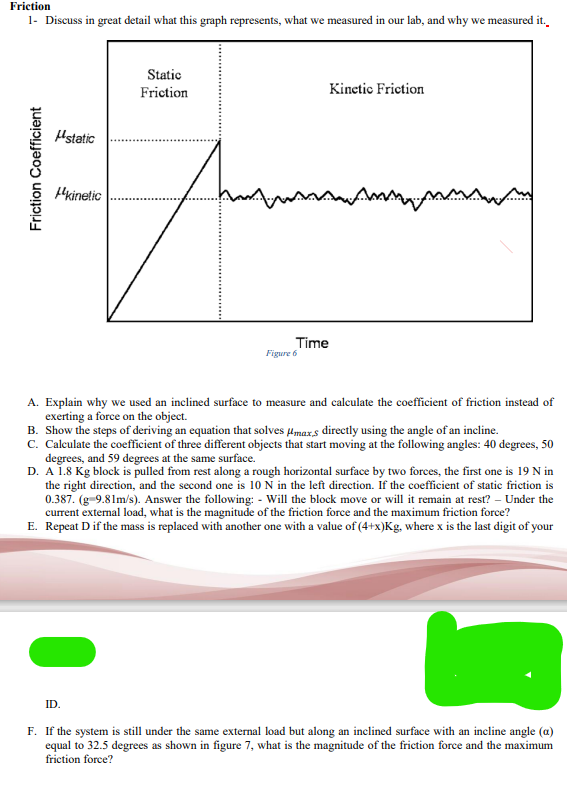Friction 1- Discuss in great detail what this graph represents, what we measured in our lab, and why we measured it. Friction Coefficient static kinetic Static Friction Kinetic Friction Time Figure 6 Am A. Explain why we used an inclined surface to measure and calculate the coefficient of friction instead of exerting a force on the object. B. Show the steps of deriving an equation that solves maxs directly using the angle of an incline. C. Calculate the coefficient of three different objects that start moving at the following angles: 40 degrees, 50 degrees, and 59 degrees at the same surface.
Friction 1- Discuss in great detail what this graph represents, what we measured in our lab, and why we measured it. Friction Coefficient static kinetic Static Friction Kinetic Friction Time Figure 6 Am A. Explain why we used an inclined surface to measure and calculate the coefficient of friction instead of exerting a force on the object. B. Show the steps of deriving an equation that solves maxs directly using the angle of an incline. C. Calculate the coefficient of three different objects that start moving at the following angles: 40 degrees, 50 degrees, and 59 degrees at the same surface.
Elements Of Electromagnetics
7th Edition
ISBN:9780190698614
Author:Sadiku, Matthew N. O.
Publisher:Sadiku, Matthew N. O.
ChapterMA: Math Assessment
Section: Chapter Questions
Problem 1.1MA
Related questions
Question
Solve A , B and C ,,,,,PLZ

Transcribed Image Text:Friction
1- Discuss in great detail what this graph represents, what we measured in our lab, and why we measured it.
Friction Coefficient
static
ID.
kinetic
Static
Friction
Kinetic Friction
mass
Time
Figure 6
www.m
A. Explain why we used an inclined surface to measure and calculate the coefficient of friction instead of
exerting a force on the object.
B. Show the steps of deriving an equation that solves maxs directly using the angle of an incline.
C. Calculate the coefficient of three different objects that start moving at the following angles: 40 degrees, 50
degrees, and 59 degrees at the same surface.
D. A 1.8 Kg block is pulled from rest along a rough horizontal surface by two forces, the first one is 19 N in
the right direction, and the second one is 10 N in the left direction. If the coefficient of static friction is
0.387. (g-9.81m/s). Answer the following: - Will the block move or will it remain at rest? - Under the
current external load, what is the magnitude of the friction force and the maximum friction force?
E. Repeat D if the mass is replaced with another one with a value of (4+x)Kg, where x is the last digit of your
F. If the system is still under the same external load but along an inclined surface with an incline angle (a)
equal to 32.5 degrees as shown in figure 7, what is the magnitude of the friction force and the maximum
friction force?
Expert Solution
This question has been solved!
Explore an expertly crafted, step-by-step solution for a thorough understanding of key concepts.
Step by step
Solved in 3 steps with 1 images

Knowledge Booster
Learn more about
Need a deep-dive on the concept behind this application? Look no further. Learn more about this topic, mechanical-engineering and related others by exploring similar questions and additional content below.Recommended textbooks for you

Elements Of Electromagnetics
Mechanical Engineering
ISBN:
9780190698614
Author:
Sadiku, Matthew N. O.
Publisher:
Oxford University Press

Mechanics of Materials (10th Edition)
Mechanical Engineering
ISBN:
9780134319650
Author:
Russell C. Hibbeler
Publisher:
PEARSON

Thermodynamics: An Engineering Approach
Mechanical Engineering
ISBN:
9781259822674
Author:
Yunus A. Cengel Dr., Michael A. Boles
Publisher:
McGraw-Hill Education

Elements Of Electromagnetics
Mechanical Engineering
ISBN:
9780190698614
Author:
Sadiku, Matthew N. O.
Publisher:
Oxford University Press

Mechanics of Materials (10th Edition)
Mechanical Engineering
ISBN:
9780134319650
Author:
Russell C. Hibbeler
Publisher:
PEARSON

Thermodynamics: An Engineering Approach
Mechanical Engineering
ISBN:
9781259822674
Author:
Yunus A. Cengel Dr., Michael A. Boles
Publisher:
McGraw-Hill Education

Control Systems Engineering
Mechanical Engineering
ISBN:
9781118170519
Author:
Norman S. Nise
Publisher:
WILEY

Mechanics of Materials (MindTap Course List)
Mechanical Engineering
ISBN:
9781337093347
Author:
Barry J. Goodno, James M. Gere
Publisher:
Cengage Learning

Engineering Mechanics: Statics
Mechanical Engineering
ISBN:
9781118807330
Author:
James L. Meriam, L. G. Kraige, J. N. Bolton
Publisher:
WILEY